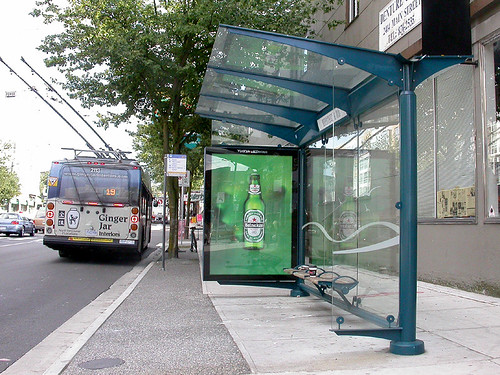
VANCOUVER — I’ve been checking out some of the street furniture that Vancouver has to offer and one of the first things that caught my attention was the treatment of bus shelters — in different neighbourhoods around the city they’re painted a specific local colour. Along slightly bohemian Commercial Drive the shelters are maroon (photo below); in the Mount Pleasant area, things are aqua-green (photo above); downtown is navy blue and in Strathcona everything is gold. In most of the outlying suburban areas the default colour scheme is metallic grey (photo below), much like Toronto’s shelters and bins.


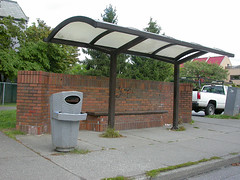 As you can see in the maroon-coloured shelter, the design is different than the other two examples. City planners told me the more angular design received poor feedback: the roof didn’t block rain blowing down from the front side; and the glass on the non-advertising side was too thin and did not block rain coming from that angle. The new design was created and it does seem to be an improvement, both functionally and aesthetically. It was also neat to stumble upon some of the older shelter designs from the early 1980s (photo at right, click to enlarge). As an aside, it’s interesting to note the similarities between Toronto’s upcoming bus shelters and the original Vancouver design.
As you can see in the maroon-coloured shelter, the design is different than the other two examples. City planners told me the more angular design received poor feedback: the roof didn’t block rain blowing down from the front side; and the glass on the non-advertising side was too thin and did not block rain coming from that angle. The new design was created and it does seem to be an improvement, both functionally and aesthetically. It was also neat to stumble upon some of the older shelter designs from the early 1980s (photo at right, click to enlarge). As an aside, it’s interesting to note the similarities between Toronto’s upcoming bus shelters and the original Vancouver design.
Vancouver’s on-street garbage and recycling bins adhere to the designated colour scheme as well (click on photos for a larger version). Something that surprised me was the lack of recycling bins — nearly all of the bins around the city seemed to mix waste and recycling. The only bins that were clearly indicated as recycling-only were grey-metallic bins found near bus shelters, and even those did not provide an option for all the other kinds of waste. For such an eco-conscious city, it seemed odd to me. Though, it may have something to do with Greater Vancouver operating an incinerator or two.
While I’m no fan of Toronto’s incoming street furniture designs, we have to try and find ways to get the most of out the situation. Residents will have an opportunity to give feedback on the designs during the implementation stages of the contract — hopefully we can wrangle the best kind of functionality and aesthetics out of Astral and the City. But something as simple as applying colour to the proposed designs could be a good start — colour can add a vibrancy to the street and set the mood or tone of a surrounding area. Parts of Toronto that are historic in nature (St. Lawrence and Corktown) could have black shelters and bins to mimic the wrought-iron lamp posts. Maybe Chinatown can be red or green.
all photos by Matthew Blackett

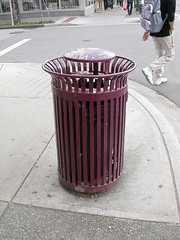
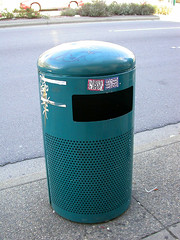
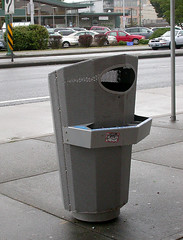
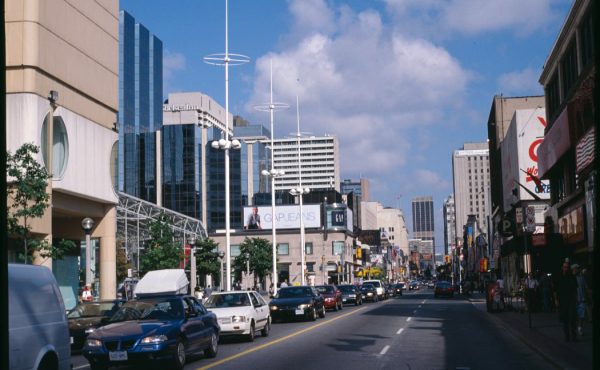


13 comments
One thing you didn’t mention: Notice the shelf in front of the opening to the grey garbage can? That’s a place to put your bottles and other returnables. In Vancouver, a binner will come by to scavenge those returnables for cash. That’s your recycling system right there! Kind of a neat way of doing it, if you ask me.
Yeah, it would be great if Ontario started a deposit on all cans and bottles
As long as it didn’t create a “pigeon park” like Van has, where bottles are harvested by the thousands
In some areas, like Gastown (which is right next to the Downtown East Side) the garbage bins are of the same design as the grey ones on the righ, but without the racks (they’re also a different colour). I figure they’re just trying to keep the binners away, but then people still have to get rid of their bottles, so people will end up digging in the bins, which seems to be what the racks were designed to prevent.
Alternatively they just don’t have garbage bins, like Yaletown. But in that case there are dumpsters (it’s on of the few places in the cities without alleys, since the ‘road’ used to, IIRC, be railway bed) and even if they’re locked they attract dumping, especially now what with the garbage strike.
Just a random point. I used to work for the Transportation and Right of Way Management department of the City a couple of summers ago as a student, and I remember my boss telling me about the significantly lagers construction costs for the new shelters. The problem with all the news designs is that they all have only 2 supporting legs in the back, and as a result, these legs have to not only take gravity loads, but have to be designed strong enough to prevent the whole structure from tipping over. To do this, the concrete platform underneath the shelter has to be reinforced concrete which is must more expensive. Older, 4 column shelters required regular concrete. They were cheaper, the platform failed less often, and there would be no issues with rebars oxidizing as a result of salt and water. While acknowledging importance of aesthetics and functionality, I think that in design of bus shelters construction and maintainance costs should play a bigger role.
I posted this last year after a visit to the West Coast, and thought I’d repost it since it seems relevant:
Vancouver and Victoria (and perhaps all of BC) have a packaging-return system in addition to what seems to be a more conventional recycling program.
People take their recyclables to an Encorp (www.encorp.ca) return-it centre and get money back, depending on the value of the items they return.
Return-it centre photos: 1,
2, 3.
Packaging Return refund chart photos:1, 2, for the right side of the chart, and 3.
It appears that this system creates a whole slew of new opportunities for managing waste in public areas. In Granville Island (a big tourist area, and food and art market) there were these bins collecting bottles for the Salvation Army. Downtown in the midst of the new condo developments, were the garbage bins discussed above, with places outside the bin for bottles, to make it easier for bottle collectors (collecting for personal income) to find them. (Here’s a couple more photos: 1,2.)
Of course there are all sorts of issues connected to this system as well (like encouraging the use of disposable/recyclable containers, and even making it a potentially charitable act to use them, and the failure to accommodate paper recycling in public places), but it definitely qualifies as a significant alternative to the way we do things here in Toronto.
Vancouver’s bins are also obviously designed to work with the existing packaging-return system and social realities like the prevalence of dumpster divers, illustrating how street furniture is but a part of larger systems–systems which are constantly changing. As we try to develop new systems and methods to deal with our waste here in Toronto, I wonder if this Astral contract will serve as a 20-year commitment to the system currently in place.
One other aspect of Vancouver bus shelters is that many of them have countdown clocks indicating when your bus will arrive.
This hugely beneficial offering is something sorely missing from other city’s shelters. This clock countdown feature allows you to nip into a store or relax while you wait knowing that you’ve got “8 minutes to arrival.”
I’d be interested to hear if anyone else is familiar with this model from other cities.
– Dabusan
I’ve seen LCD displays in England that tell you when the next bus is coming along and, although I’ve not seen them in operation, I know some cities have a cellphone system that will text message you when a bus is, for example, a few minutes away.
One thing the Vancouver shelters all seem to do is open out onto the road. Here in Toronto the shelters to my recollection are open facing the pavement. That seems to make a lot more sense to me. If your shelter is open to the road you need space in front of it to create a ‘safe zone’, whereas a shelter open to the pavement can sit close to the curb.
All those pictures of shelters in Vancouver above are sitting in the middle of the pavement. If the shelters were open towards the pavement they wouldn’t need to interrupt pedestrian flow.
*All references to ‘pavement’ should be read as ‘sidewalk’ (I’m a brit).
Slightly off topic, but note the vehicle in the first photo is a trolleybus. We lost these nearly two decades ago thanks to the combined machinations of TTC management, Queen’s Park and the natural gas industry who had (at that time) a surplus of product to sell.
The trolleybuses contribute to the street environment through their low noise level and absence of exhaust.
The reason you didn’t see any recycling bins in public spaces in Vancouver is because they are not really needed. The bottle collectors keep the streets and parks quite spotless, and frankly I think it’s a win-win situation. They get extra money and we all get to enjoy the cleanliness of the city. I wish Toronto would follow suit and implement a packaging return system, or at least encourage some local entrepreneur to do so!
The clock countdown lets you nip into a store or relax… it also tells you whether you should even bother waiting if your trip is going to be relatively short. When I head from Consumers Road to Vic Park on Sheppard, it’s far enough that I’d rather not walk given the (supposed) frequency of the Sheppard bus. But when the Sheppard bus is late or bunched up, I feel like a fool because I could have walked to Vic Park by then, which could be the difference between making and missing a connecting bus.
The trolley bus was the first thing I noticed too… note also that it’s one of the new ones. Yes, a new trolley bus!
A couple comments to add:
Although not all of the bus shelters have LCD posts that tell you when the next bus is coming, they all have a number on the transit stop that you can call to hear how long before the next bus arrives. You can then decide whether to stay or walk.
As an environmental aside, the trolley buses here are run on hydroelectricity, meaning that they produce zero-emissions to operate! Not only that, but most of the buses in Vancouver feature bike racks. Very useful when you don’t want to bike up the hill to UBC.
Regarding the gray garbage bins with the recycling shelf – that is an awkward retrofit of the original design which only had the opening in front (and through which binners cannot easily rummage through the bin for bottles and cans).
I think the City has decided to retrofit all of the City’s garbage bins of that design with the shelf to prevent binners from opening the back of the bin and pulling out the bin inside to sift through the garbage to get cans and bottles.
The bins that were replaced were heavy concrete bins that were open on top and easy to rummage through.
You often see the new bins opened up from the back and rummaged through.
Talking about the colours of the street furniture in Vancouver, another interesting neighbourhood feature to note is Davie Street, which is the heart of Vancouver’s gay community. The street furniture on Davie Street is all hot pink.
Check it out – http://www.flickr.com/search/?q=vancouver%20davie%20pink&w=all